#Guadalupe Rivera
Explore tagged Tumblr posts
Text
Diego el rojo
Diego el rojo #aperturaintelectual #palabrasbajollave @tmoralesgarcia1 @moralesgarciathelma Thelma Morales García
#AperturaIntelectual#palabrasbajollaveAI#@moralesgarciathelma#@tmoralesgarcia1#Arte#Cultura#Diego el rojo#Diego María Rivera Barrientos#Diego Rivera Acosta#doña María Barrientos#gobernador Teodoro Dehesa#Guadalupe Rivera#Hija de Diego Rivera#Liceo Católico Hispano Mexicano#Liceo Francés#palabrasbajollave#Personajes#Poesía#profesor Ledoyen#Real Academia de Bellas Artes de San Carlos#Thelma Morales García
3 notes
·
View notes
Text

Happy Dia de los Muertos to la Calavera Catrina!
🇲🇽💀🎀
#history#dia de los muertos#day of the dead#la calavera catrina#josé guadalupe posada#mexican history#diego rivera#dreams of a sunday afternoon in alameda park#1910s#illustration#art history#latin america#historical figures#mexico#coquette#latina#art#embrace your roots#womens history#newspaper#historical art#mexican culture#be who you are#nickys facts
20 notes
·
View notes
Text










Mexico City
21 notes
·
View notes
Text
“Día de Muertos en México: Cómo el Cine y la Mercadotecnia Internacional Han Revitalizado la Tradición de las Catrinas”
Ing. José María Noriega C.A.S. La integración de la mercadotecnia en las tradiciones culturales, como el Día de Muertos en México, ha demostrado ser un fenómeno fascinante. Esta celebración, rica en simbolismo y significados ancestrales, ha trascendido sus raíces para cautivar al mundo entero. En el corazón de esta evolución se encuentra el trabajo de artistas como José Guadalupe Posada y…
#advertising#AI#AIART#alebrijes#Arte#arte popular mexicano#Avenida Reforma#calaveras mexicanas#Catrinas#cine y tradiciones#Cinematografía#Coco Disney Pixar#cultura mexicana#desarrollo de Negociod#desfile de Día de Muertos#Dia de Muertos#Diego Rivera#estrategia#Excellence#Experto#festividades mexicanas#Ing. José María Noriega#James Bond Spectre#José Guadalupe Posada#marketing#marketing cultural#Mercadotecnia#mexico#ofrendas#Oportunidades
2 notes
·
View notes
Text
¿SABÍAS QUE LOS MEXICAS NO SE DISFRAZABAN DE CATRINAS?
Los mexicas NO se pintaban los rostros de calaveras ni se disfrazaban de catrinas.
“La Catrina” no proviene de los mexicas. Es una sátira creada por el caricaturista José Guadalupe Posada que en tiempos del juarismo y el porfiriato se burlaba de los mestizos e indígenas que iban subiendo de nivel económico y pretendía ser europeos y renegaban de su propia raza, herencia y cultura. Se les llamaba los “garbanceros”, precisamente por dedicarse al cultivo y venta de garbanzos.
Entonces José Guadalupe Posada, creó “La Calavera Garbancera” para expresar que los garbanceros andaban «...en los huesos, pero con sombrero francés con sus plumas de avestruz».
Diego Rivera la nombró “La Catrina”, de la palabra “catrín”, que definía (a veces de forma despectiva) a la clase social alta, y la eternizó en su mural “Sueño de una tarde dominical en la Alameda Central”, (la calavera con su estola de plumas aparece junto a José Guadalupe Posada, Diego Rivera como niño y Frida Kahlo).
Imagen: mural “Sueño de una tarde dominical en la Alameda Central”, de Diego Rivera.
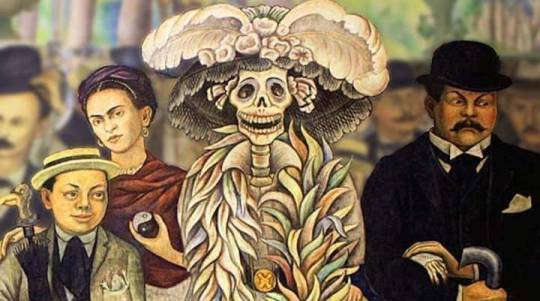
#mexico#dia de muertos#catrina#jose guadalupe posada#diego rivera#sueño de una tarde dominical en la Alameda Central
13 notes
·
View notes
Text

Guadalupe Marin de Rivera. 1924
Foto: Edward Weston
18 notes
·
View notes
Text





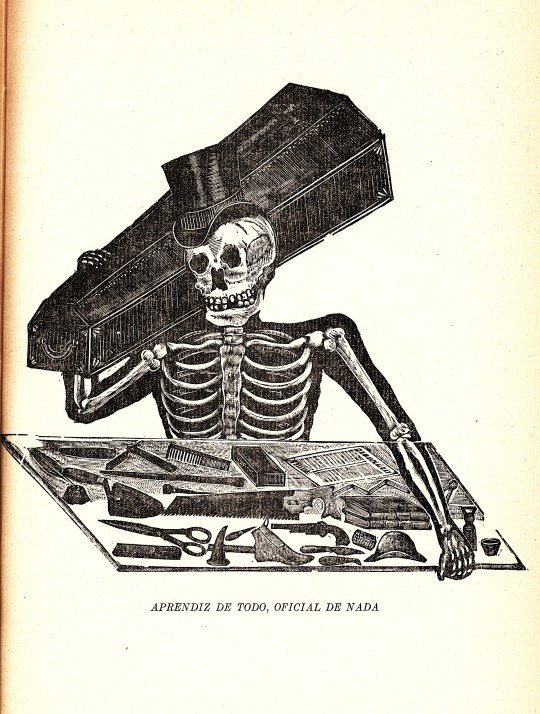

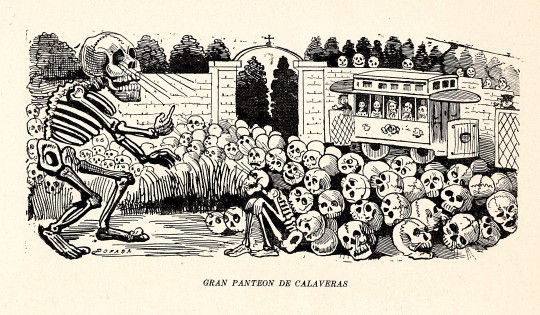

Dia de los Muertos 2024
We commemorate Dia del los Muertos with woodcuts by the Mexican printmaking satirist José Guadalupe Posada Aguilar (1852-1913) from the 1930 publication Monografía: Las Obras de José Guadalupe Posada, grabador mexicano, edited by American ethnographer Frances Toor (1890-1956), American Mexican artist Paul O'Higgins (1904-1983), and Posada's contemporary and colleague Blas Vanegas Arroyo (1852-1917), with an introduction by the prominent Mexican artist Diego Rivera (1886-1957), published in Mexico City by Mexican Folkways.
Calaveras and calacas are closely associated with Day of the Dead celebrations, and this Posada monograph contains many examples.
View other posts with works by Posada.
View other Dia de los Muertos posts.
#Dia de los Muertos#Day of the Dead#holidays#José Guadalupe Posada Aguilar#José Posada#j. g. posada#Posada#Monografía: Las Obras de José Guadalupe Posada#woodcuts#Frances Toor#Paul O'Higgins#Pablo O'Higgins#Blas Vanegas Arroyo#Mexican Folkways#calaveras#calacas#skulls
266 notes
·
View notes
Text
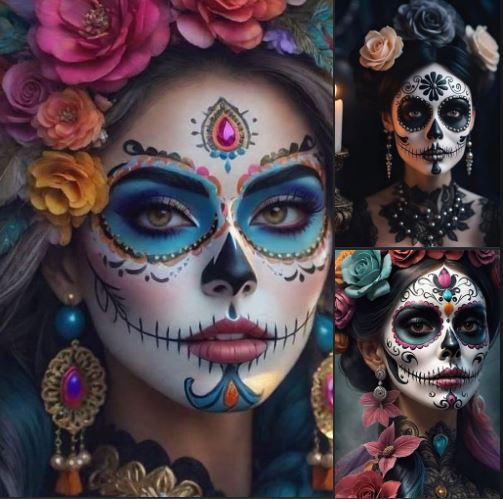
¿QUE ES LA CATRINA?
La Catrina es un personaje creado por el pintor, ilustrador y caricaturista mexicano de Aguascalientes, José Guadalupe Posada, es la figura que más se asocia al Día de Muertos y a la muerte en general en nuestro país, siendo uno de los iconos con los que México es conocido en el mundo entero. Cabe mencionar que la versión original de La Catrina es un grabado en metal del artista.
La Catrina como símbolo mexicano, su nombre original es “La Calavera Garbancera”, “garbancera” es la palabra con que se conocía entonces a las personas que aun teniendo sangre indígena dejaron de vender maíz para vender garbanzos pretendiendo ser europeos ya fuera españoles o franceses y renegando así de su propia raza, herencia y cultura.
No fue hasta 1947 cuando el muralista Diego Rivera usó a este personaje, dándole el atuendo elegante que hoy en día todos conocemos, bautizándola como "La Catrina", en su mural “Sueño de una tarde dominical en la Alameda Central”.
En la actualidad la figura de "La Catrina" es la imagen más representativa del Día de Muertos y México. Hoy en día es uno de los disfraces y maquillajes más utilizados, dejó de ser un dibujo en papel para convertirse en un elemento de nuestra cultura mexicana totalmente vivo.
Sin Censura Radio
22 notes
·
View notes
Text

My lover, partner in crime, and guide in another dimension: Catrina.
Title: “Catrina”
Post-Art Series: “Catrinas”
👁️⃤X 𝔪𝔦𝔵𝔢𝔡 𝔪𝔢𝔡𝔦𝔞 𝔭𝔬𝔰𝔱-𝔞𝔯𝔱 (digital illustration)
Links to OpenSea and my website: @ofb1t
💀🖤Catrinas open the portal to our non-human dimension (which means freedom), rejecting the illusion of a singular 'human nature,' so neglected these days.
𝔗𝔥𝔞𝔫𝔨 𝔜𝔬𝔲
𝔊𝔯𝔞𝔠𝔦𝔞𝔰
◐𐍆ᛒ1𝚪 (҂0_✘)
🕸🕷°⋆・✧・゚࿐ ࿔✧・゚࿐ ࿔
"Catrinas" is a dark fantasy, surrealist, and gothic mixed media post-art series.
The Catrinas series vibrantly explores the iconic Mexican Catrina as an interstitial force between the human and the nonhuman. Created by caricaturist José Guadalupe Posada as a critique of society, La Catrina was later reimagined by Diego Rivera, solidifying her status as a beloved icon.
Each piece in this series is titled Catrina, inviting viewers to see her as a timeless archetype that embodies universal death and critiques societal norms. This repetition encourages exploration of identity as an infinite series of differences, questioning the notion of a 'fixed' self and emphasizing La Catrina as a force reflecting mortality and social commentary.
Originally mocking superficiality and class hypocrisy, La Catrina's spirit of satire endures. This series captures that essence and reimagines her in surreal, gothic worlds where the mundane merges with dark fantasy, inviting sensory exploration of difference, mortality, and cultural memory through a uniquely Mexican style.
#catrina #illustration #digitalart #posthumanism #Mexico #illustration #gothic #goth #darkfantasy #fantasyart #surrealism #explorepage #weirdart #creative #contemporaryart #cosplay #halloweenart #creepycute #diadelosmuertos #cutemonster #christmas #beautiful #beautyful #otaku #aiartdaily #aiart #conceptualart #foryourpage #animecore #ofb1t
#catrina#illustration#digitalart#posthumanism#Mexico#gothic#goth#darkfantasy#fantasyart#surrealism#explorepage#weirdart#creative#contemporaryart#cosplay#halloweenart#creepycute#diadelosmuertos#cutemonster#christmas#beautiful#beautyful#otaku#aiartdaily#aiart#conceptualart#foryourpage#animecore#ofb1t
7 notes
·
View notes
Text


Guadalupe Victoria:
"His life is absolutely incredible. Successful commander. Absolute menace to the Spanish. Changed his name to show his dedication to Mexican independence. Part of the triumvirate that overthrew Iturbide. The only president in the early years of the Mexican republic to serve his full term. Absolutely incredible."
“An absolutely amazing man, he prohibited the sell and purchase of slaves, founded the National Museum, the only president to finish his term as president in over 35 years of Mexico’s independence.”
“Hay una historia de como defendió al país aun después de muerto. Su último deseo fue que esparcieran sus restos por todo el país que ayudó a construir. Sus órganos internos se quedaron en botellas con aguardiente y vino.
Cuatro años después dos soldados gringos se tomaron las botellas y se ganaron un pase VIP con san Pedro. Por lo que después de muerto Don Guadalupe mató a 2 soldados en defensa de la patria”
José Fructuoso Rivera y Toscan:
a. “THE SMOLDER…THE DARK BROODING EYES….I WOULD DECLARE INDEPENDENCE FROM LIVING FOR HIM”
14 notes
·
View notes
Text
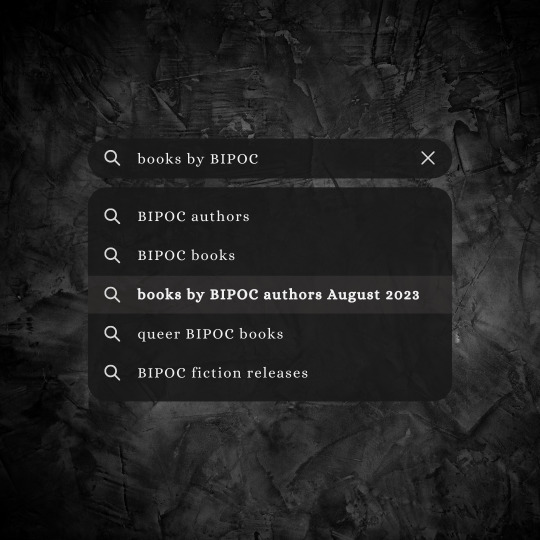


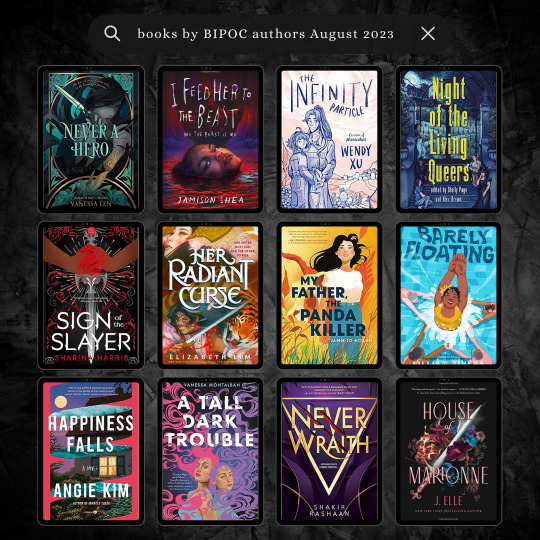
Books by BIPOC Authors August 2023
🦇 I grew up surrounded by a melting pot of cultures, diverse communities, and unique experiences. Despite the different sources of those multicultural voices, their stories still covered universal topics of colonialism, migration, identity, and race. Each story was another flavor, another sweet spice adding to that melting pot. Today, we have books by BIPOC authors that put those unique voices to the page. If you're interested in traveling to different worlds, whether familiar or foreign, here are a few books by BIPOC authors to add to your TBR! 🦇
✨ Tomb Sweeping by Alexandra Chang ✨ The Dark Place by Britney S. Lewis ✨ Forged by Blood by Ehigbor Okuson ✨ Accidentally in Love by Danielle Jackson ✨ A Council of Dolls by Mona Susan Power ✨ Still Born by Guadalupe Nettel, translated by Rosalind Harvey ✨ The Injustice of Place: Uncovering the Legacy of Poverty in America by Kathryn J. Edin, H. Luke Shaefer, Timothy J. Nelson ✨ Hangman by Maya Binyam ✨ The Heaven & Earth Grocery Store by James McBride (Historical Fiction) ✨ Under the Tamarind Tree by Nigar Alam ✨ Vampires of El Norte by Isabel Cañas ✨ An American Immigrant by Johanna Rojas Vann
🧭 Forgive Me Not by Jennifer Baker 🧭 Two Tribes by Emily Bowen Cohen 🧭 A Quantum Life: My Unlikely Journey from the Street to the Stars by Hakeem Oluseyi and Joshua Horwitz 🧭 Writing in Color: Fourteen Writers on the Lessons We've Learned (edited by) Nafiza Azad and Melody Simpson 🧭 Ghost Book by Remy Lai 🧭 The Water Outlaws by S.L. Huang 🧭 Plantains and Our Becoming by Melania Luisa Marte 🧭 Forty Words for Love by Aisha Saeed 🧭 The Great White Bard: How to Love Shakespeare While Talking About Race by Farah Karim-Cooper 🧭 Take the Long Way Home by Rochelle Alers 🧭 Swim Home to the Vanished by Brendan Shay Basham 🧭 Actually Super by Adi Alsaid
✨ Never a Hero by Vanessa Len ✨ I Fed Her to the Beast and the Beast is Me by Jamison Shea ✨ The Infinity Particle by Wendy Xu ✨ Night of the Living Queers, edited by Shelly Page ✨ Sign of the Slayer by Sharina Harris ✨ Her Radiant Curse by Elizabeth Lim ✨ My Father the Panda Killer by Jamie Jo Hoang ✨ Barely Floating by Lilliam Rivera ✨Happiness Falls by Angie Kim ✨ A Tall Dark Trouble by Vanessa Montalban ✨ Neverwraith by Shakir Rashaan ✨ House of Marionne by J. Elle
#books#book list#book recommendation#bipoc#bipoc stories#support bipoc#batty about books#battyaboutbooks
37 notes
·
View notes
Text
Posada y la imagen de la muerte
Posada y la imagen de la muerte #aperturaintelectual #palabrasbajollave @tmoralesgarcia1 Thelma Morales García

View On WordPress
#AperturaIntelectual#palabrasbajollaveAI#Arte#Arte Popular Mexicano#Carmen Caballero#Cultura#Diego Rivera#Festividad de Día de Muertos#Humor satírico#José Guadalupe Posada#La Calavera Garbancera#La Catrina#Las calaveritas de Posada#Periódico "El Jicote"#Personajes#Poesía#Thelma Morales García
5 notes
·
View notes
Text
Stardew Valley but you're at a Mexican Rancho
The Playlist
And here you have it friends, the cursed playlist that started it all. Every time I played the game during my first playthrough, there were some character plotlines or in-game events that reminded me of ranchero, regional mexicano, or banda songs from my country, and the fact that all those songs are linked to the idealized culture of rural areas of my country, and that Stardew is basically a farming game, made sense to my weird neurodivergent brain. So here you go, the playlist and which songs I relate to each character.
The list is ordered as follows:
Song title - Artist
Character/Event I relate the song to and why.
If you have any questions/comments, feel free to jump to the end of this playlist for my Author's Note
WARNING: THIS PLAYLIST DESCRIPTION CONTAINS SPOILERS FOR IN-GAME / HEART EVENTS.
Los Agachados - Maldita Vecindad y los Hijos del 5to Patio
Character/Event: You know when we meet our main character and they are stuck in their routine, in a crowded city working a job that they don't like, 9 to 5? Well that happens too often down here, but in Mexico, for as long as we can remember, all that tediousness is alleviated by hanging out with our buddies and eating with our families or friends. The golden age of Mexican cinema reflects that enduring part of our history. This song is a homage to Tin-Tán Valdez's movies.
2. Mi Ciudad - Guadalupe Trigo
Character/Event: After our MC gets the letter from their Grandpa and has the opportunity to move to Pelican Town, during their bus ride they start to say goodbye to their city, looking forward to the possibilities that the new location offers. It's not that they hate the city, they just needed to grow their roots somewhere else, so the journey is filled with gratitude.
3. Recuérdame - Carlos Rivera
Character/Event: Grandpa's message. Ah, the favorite singer of Mexican moms and abuelas, it was only natural that this song helps MC reminisce about their summers in Pelican Town and their late grandpa. Do I hate that Disney tried to trademark a national tradition? absolutely, but the soundtrack from Coco slaps, especially in Spanish.
4. Árboles de la Barranca - Antonio Aguilar
Character/Event: The Farm. This one is self-explanatory for Spanish speakers. After MC's (now Farmer) arrival on the farm, they look at the condition of everything. "Árboles de la barranca, ¿Por qué no han enverdecido?" (Translation: Trees of the ravine, why haven't you gone green again?) and look at all the work they have ahead of them.
5. Soy de Rancho - El Komander
Character/Event: This is when MC becomes the Farmer. Maybe after their first Spring in Pelican Town or selling their first successful crops, the Farmer is getting the hang of things and are fully taking pride in the progress they've made.
6. La Granja - Los Tigres del Norte
Character/Event: The Community Center / The Barn / Lewis / Joja Co. Los Tigres del Norte are almost ubiquitous in representing Mexican culture all over the world, and it's only natural that this song (one of their hardest critiques to corruption) appears here. After managing to get a barn and their first animals through their hard effort, meeting the Junimos at the community center, and getting tasked by Lewis with the repair of the building, the Farmer begins to think that maybe the city and Pelican Town aren't so different in terms of the lack of care from their representatives. Lewis isn't necessarily bad, he's a nice man who cares about his community... but he has enough money to buy truffle oil and create a golden statue of himself while the community center has been abandoned and JojaMart is messing with local businesses. The problem isn't the lack of resources, but the greed and hunger of a few (which the Tigres del Norte song addresses directly)
Author's Note: Thanks for reading this first part of the playlist and feel free to leave me your comments/questions/asks. In the next post, due to the length of this one, I'll talk more about the other songs in the playlist and what they mean for the universe in my playthrough, especially, the ones I gave to the romanceable characters.
#stardew#stardew valley#stardew fanfic#stardew valley fanfic#sdv fanfic#sdv fanart#playlist#explained playlist#expanded universe#mexican culture#Spotify#stardew farmer#stardew valley farmer#stardew fanart#stardew valley fanart#sdv#sdv farmer#stardew shane#stardew sebastian#harvey stardew valley#sebastian stardew valley#stardew valley elliott#stardew Lewis
29 notes
·
View notes
Text






Book 519
J.G. Posada: Messenger of Mortality
Julian Rothenstein, ed.
Moyer Bell Limited 1989
I think José Guadalupe Posada (1852-1913) may be one of my favorite artists. His work speaks to so many aspects of my own personality—satirical, humorous, populist, absurd, and with a great appreciation for the morbid. So, I think it’s a bit of a crime that there aren’t more books of his work published in this country. It is estimated that over the course of his career he produced over 20,000 images, but, despite that, he died penniless and forgotten. However, it wouldn’t be long after his passing that he would be rediscovered and studied by such artists as Rivera and Kahlo, and then by Europeans such as Eisenstein and the French surrealists. Posada saw and memorialized life as it happened around him—the working people, riots, natural disasters, suicides, murders, and crimes—but it is his calaveras, the skulls used to commemorate the Day of the Dead, which he used to expose hypocrisy and reveal the ultimate absurdity of humanity, that he is best remembered.
#bookshelf#library#personal collection#personal library#books#bibliophile#book lover#illustrated book#booklr#graphic design#Jose Guadalupe posada#messenger of mortality#julian rothenstein#art#moyer bell
3 notes
·
View notes
Text
¿Conoces la historia de la Catrina?
José Guadalupe Posada es el creador de la conocida calavera “La Catrina”, sin embargo, este no es el nombre original que él diera a su creación, la llamó “Calavera Garbancera”. Debido a que en 1912 se percató de la existencia de un grupo de mujeres mexicanas que aspiraban a ser como las españolas y quienes, al no contar con los recursos para adquirir sus sombreros, ellas mismas los confeccionaban, en muchas ocasiones haciéndolos de mayor tamaño y vistosidad. Por otra parte, habían decidido no comer maíz como acostumbran los mexicanos sino comer garbanzo como los españoles, ante esta realidad Posada se burló de ellas con la “Calavera Garbancera”.
Diego Rivera fue quien la bautizó con el nombre que hoy le damos, esto debido a una investigación publicada en 1920 sobre la vida y obra del grabador nacido en Aguascalientes, a quien admiraba profundamente.
Diego Rivera pintó a la Catrina en un lugar protagónico de su mural 'Sueño de una tarde dominical en la Alameda Central. Además fue Rivera el creador del cuerpo que luce la Catrina, ataviada de un vestido a la moda europea, paseando de la mano de Diego y de José Guadalupe Posada.
💀🌼💀🌼💀🌼💀🌼💀🌼💀🌼💀🌼💀🌼💀
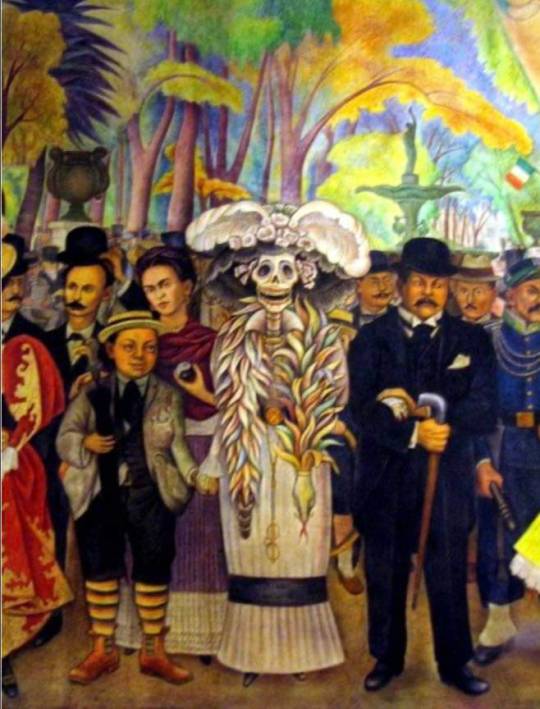
8 notes
·
View notes
Text

José Clemente Orozco
Nacimiento: 23 de noviembre de 1883; Ciudad Guzmán, Mexico
Fallecimiento: 7 de septiembre de 1949; Mexico City, Mexico
Nacionalidad: Mexican
Movimiento: Realismo Social, Muralismo, Indigenism
Escuela/grupo: Mexican Mural Renaissance
Campo: pintura
Influenciado por: Francisco de Goya, El Greco, Giotto, Miguel Ángel, Cubismo, José Guadalupe Posada
Influenciado en: Jackson Pollock, Philip Guston, Frida Kahlo, Vlady Kibálchich Rusakov, Muralismo
Institución de arte: Academia de San Carlos, Mexico City, Mexico
Amigos y compañeros de trabajo: Diego Rivera, David Alfaro Siqueiros
Wikipedia: es.wikipedia.org/wiki/José_Clemente_Orozco
6 notes
·
View notes